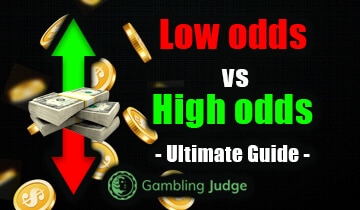Low Odds vs High Odds – Turn Any Odds into Profit

Low odds and high odds are two sides of the same coin. This betting guide highlights the advantages and shortcomings of each type of odds. You will learn how the decision between high odds vs low odds comes down to the same concept: risk management.
When the odds are low, you take fewer chances but settle for lower profits. The odds are high meaning implies more significant risks but the possibility of winning more if you make the right choice.
- 1What are low odds?
- 2Pros and Cons of low odds betting
- 3What are high odds?
- 4Pros and Cons of high odds betting
- 5Why do the betting odds keep changing?
- 6Betting odds explained
- 7The odds range value explained
- 8The confusion between odds and probability
- 9Low odds and high odds betting strategies
- 10High odds vs low odds - The bottom line
- 11FAQs about betting on low and high odds
Top 10 Bookmakers with the Best Odds in 12 December 2025 – Updated List
What are low odds?
Pros and Cons of low odds betting
PROS
- Positive return over time
- More chances to place separate bets
- More betting opportunities
CONS
- Less time to research bets
- Bigger losses
What are high odds?
Pros and Cons of high odds betting
PROS
- Potential to score big wins
- Low stakes can have big payoffs
CONS
- Easier to accumulate losses over time
- Less betting opportunities
Why do the betting odds keep changing?
The odds offered by the bookmaker for a particular event change continuously until that event starts. This change can be up or down. If you are betting large amounts on low odds or high odds, you must find out how bookies set the odds. Because even high odds bookmakers can dramatically decrease the rates they offer for a particular event. To answer this question, let’s first remember the basics.
Odds are used even on e-sports betting sites and they give information about two things. One is how much money you can earn when you place a bet on that outcome (potential winnings) and two is the probability of that outcome happening. The odds offered for an event may change due to any development, but there are usually two reasons for this:
Learning why odds change and how high odds betting sites work is of crucial importance. Before you bet big in low odds (or do the opposite), make sure to learn the basics. This is the best sports betting strategy we can advise, and these basics are important for all other strategies, such as football strategies and systems, prop betting strategy, over under betting, and even low and minimum betting stakes.
Other articles you might want to read:

Negative Odds Meaning – What They Are and How They Work

What Does Bar Mean in Betting? | Make Underdogs Pay
Betting odds explained
In order to create a low odds betting strategy and place a winning bet, you must first learn the numbers you see on the screen and their meanings. All of the best betting sites with high odds use one of these formats by default, but switching to other formats is always possible:
The odds range value explained
The confusion between odds and probability
As mentioned before, when live betting and looking at lower odds vs higher odds (or high odds vs low odds), people often get confused. A lot of this is due to people confusing odds with probability. Probability can be defined as the number of times we can expect an event to occur during many trials, and it always ranges between 0-1. However, the odds are different. They’re the probability that an event will occur divided by the probability that the same event will not occur.
Low odds and high odds betting strategies
Tip
- With betting high on low odds, players can slowly build up a nice stack of winnings since the chances of a loss are lower. However, if you do lose, you’ll lose quite a high stake.
- With low on high odds, the wins and losses are reversed. Over time, players might end up amassing quite a big pool of losses if they’re not lucky enough to snag a win, but if they do end up getting one, they’re golden.
Like with all betting, the most important part of betting low on high odds and betting high on low odds is learning to best manage your money. This way you can make the most out of your experience and know when it’s time to cut your losses and take a break.
High odds vs low odds - The bottom line
When betting for fun or profit, the decision always comes down to minimizing risks. If you want frequent winnings, you should celebrate when the odds are low on different sports. To maximize your sports betting gains, our betting advice is to look for matches and markets where the odds are high.
The low odds vs high odds debate is here to stay. Ensure you understand the betting terms and choose low or high odds based on your expectations. Exercise proper bankroll management and find value in every odd to be successful in your sports betting quest.
FAQs about betting on low and high odds:
Both high and low odds offer their unique advantages and disadvantages. Depending on what type of betting experience you’re looking for, one or the other might suit you best.
Odds and chances are not the same thing. Odds represent a ratio of favorable to unfavorable outcomes, while chances (probability) indicate the likelihood of an event happening.
Betting on low odds long-term is a “safer” way of betting but it isn’t necessarily better. Since the chances of winning when betting on low odds are higher, the player can accumulate solid winnings over time.
Betting on high odds long-term might minimize a player’s losses if they place low stakes bets but it isn’t necessarily a better betting strategy. However, if the player does manage to win their wins will be much bigger than their stake.
Both low odds and high odds betting offer some great benefits that bettors can take advantage of. It's generally safer to bet high on low odds since they represent a higher probability of winning, while betting low on high odds minimizes risk in less likely outcomes.













